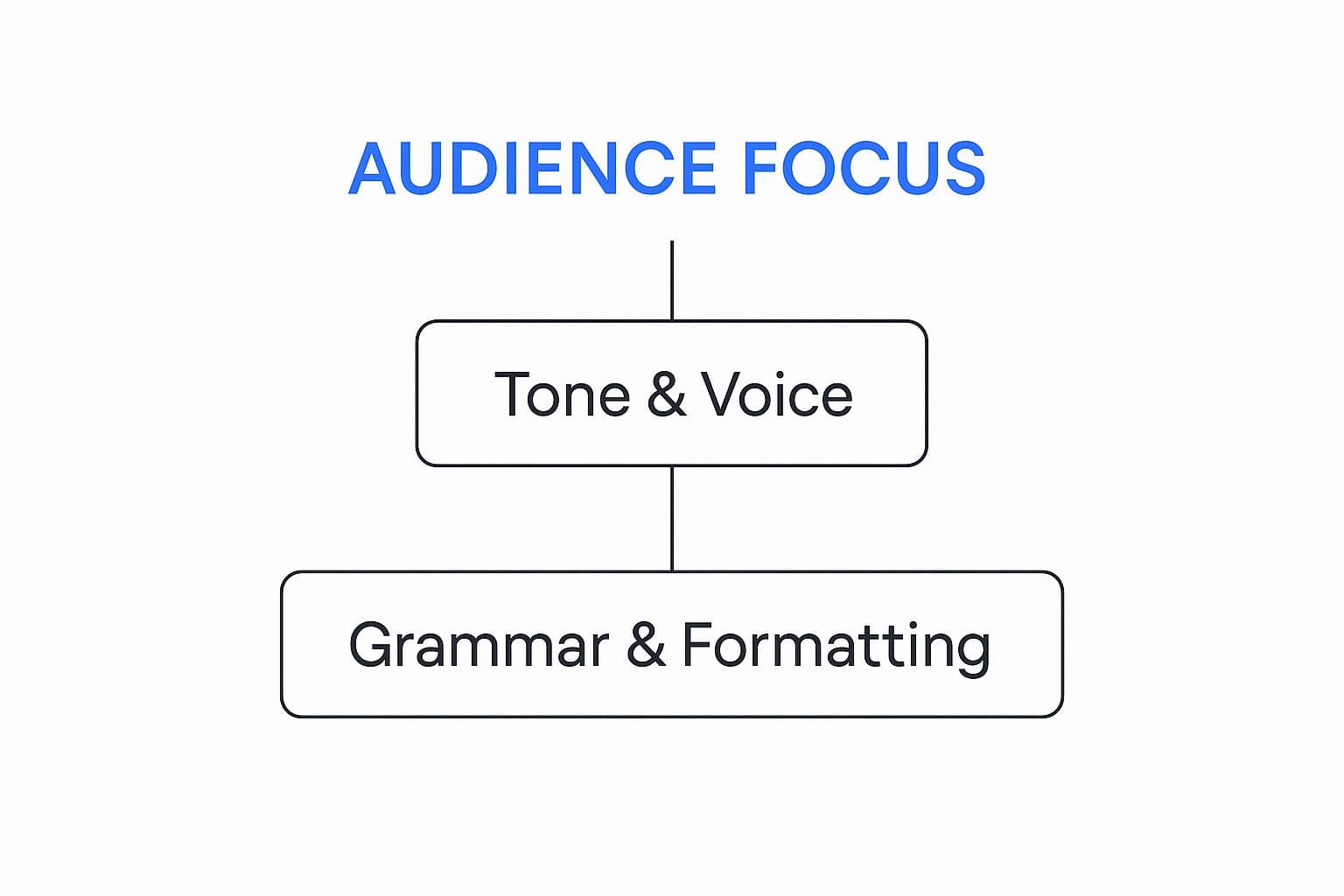Ultimate Business Writing Style Guide for Clear Communication
Unlock the secrets of effective communication with our comprehensive business writing style guide. Perfect for professionals seeking to improve their writing.

Think of your company’s communication like a signature dish at a restaurant. A business writing style guide is the secret recipe. It’s the one document that makes sure everyone—from sales to marketing to customer support—is using the same ingredients and following the same steps. The result? A consistent and instantly recognizable flavor in everything you write.
This guide becomes the go-to playbook for all your company's written materials, whether it's a quick internal memo or a major client-facing proposal.
What Is a Business Writing Style Guide

At its heart, a business writing style guide is the rulebook that sets the standard for every single word your company puts out there. It’s so much more than a stuffy grammar pamphlet; it’s the North Star for your brand’s voice, tone, and unique personality.
Think about it. What if you received two emails from the same company on the same day? One sounds stiff and corporate, packed with jargon. The other is breezy, friendly, and even throws in an emoji. It’s confusing, right? That kind of inconsistency can make a brand feel disjointed and untrustworthy. A style guide is your secret weapon against that chaos.
Creating a Unified Brand Voice
The number one job of a style guide is to create consistency. When every single piece of communication—from a simple tweet to your comprehensive annual report—sounds like it came from the same brain, you build an incredibly strong and memorable brand.
This consistency naturally builds trust and a sense of professionalism. Your customers, clients, and partners learn what to expect from you, which makes their relationship with your brand feel more stable and reliable. It’s all about making your company’s voice so distinct that people recognize it immediately, no matter which team member is actually typing. If you want to dive deeper into this, check out our guide on how to write professionally.
Beyond Grammar and Punctuation
Sure, a style guide will settle the great debate over the Oxford comma. But its real power lies in defining how your brand shows up in the world. It’s less about a single punctuation mark and more about shaping the entire personality of your communication.
To give you a clearer picture, here’s a quick rundown of what a great style guide typically includes.
Key Style Guide Components at a Glance
This table breaks down the core pillars of a solid business writing style guide. Think of these as the non-negotiable sections you'll want to build out.
| Component | What It Covers |
|---|---|
| Voice & Tone | Defines the personality. Are you formal and expert, or casual and witty? Provides examples. |
| Grammar & Punctuation | The technical rules. Settles debates on commas, capitalization, and common grammar slip-ups. |
| Formatting | Visual consistency. How to structure headings, lists, bold text, and blockquotes. |
| Word Choice & Jargon | Your company's dictionary. Lists preferred terms and flags industry jargon to avoid. |
| Inclusive Language | Guidelines for using respectful, bias-free language that welcomes everyone. |
These components work together to provide a complete framework, ensuring nothing is left to guesswork.
By getting everyone on the same page with these elements, a style guide gets rid of the guesswork. It empowers your team to write with confidence, knowing they are perfectly representing the brand every single time.
In the end, a business writing style guide is an essential tool for any company that cares about its reputation. It’s not just a document—it’s a practical asset that helps your entire team work smarter, communicate clearer, and present a truly united front to the world.
The Evolution of Business Writing

The direct, reader-focused communication we expect in business today didn't just appear out of nowhere. To really get why a modern business writing style guide is all about clarity, it’s helpful to see how we got here. These principles weren't dreamed up in a recent board meeting; they were shaped over centuries of trade and commerce.
Think about trying to close a deal using Shakespearean English. It sounds absurd, but for a long time, business writing was almost that stuffy and formal. It was bogged down by rigid formulas that cared more about tradition than getting a point across. The goal wasn't to connect with a person, but to follow a strict professional and social script.
From Formal Rules to Functional Needs
This super-structured way of writing started to crack as the business world got faster and more complicated. A growing merchant class figured out that flowery, roundabout letters were just plain inefficient. They needed communication that was clear, functional, and could be understood quickly by partners in different parts of the world. Practicality finally started to beat pageantry.
The core idea behind modern style guides—write clearly for your audience—isn't new. It’s a direct response to a timeless business need: communication that gets things done without confusion.
You can actually see this shift in historical records. Medieval business letters, like some from 15th-century London, followed a strict five-part structure: address, salutation, notification, exposition, and closing. But as the Renaissance kicked off, traders and merchants began to ditch these formal chains for more direct styles that simply worked better for getting business done. You can dig deeper into this fascinating history of early business writing practices.
This evolution shows how the "rules" of business writing became more democratic over time. They moved away from elitist, overly formal traditions toward a style that served the real-world needs of an expanding middle class.
Why This History Matters Today
Knowing this backstory gives you a much better perspective on your own work. The principles you'll lay out in your business writing style guide are part of a long, practical tradition of making communication more powerful. They’re time-tested tools for building relationships and getting people to act.
Here’s what this journey teaches us:
- Clarity is Timeless: The demand for clear, simple language isn't some new fad. It's a fundamental principle that's been refined for hundreds of years.
- Audience is Everything: The most effective communication has always put the reader’s needs front and center.
- Adaptability is Key: Business writing has always evolved with the tools of the era, from quill pens and handwritten letters to the instant digital messages we use today.
At the end of the day, your style guide isn't just a document of arbitrary rules. It's the modern chapter in a long story proving one simple truth: clear writing is just good business.
Why Your Business Needs a Style Guide
Let's be honest, a business writing style guide sounds a bit stuffy, doesn't it? Like some dusty rulebook nobody actually reads. But in reality, it’s one of the most powerful tools you can have. Think of it less as a rulebook and more as the central playbook for your company's communication. Without it, you’ve got every team member running a completely different play, leading to confusion for your audience and a messy brand image.
When everyone writes in their own style, your brand feels chaotic. A customer might get a super formal, jargon-packed email from your support team, only to then see a funny, casual meme from your marketing team on Instagram. This kind of whiplash makes your brand feel unreliable and, frankly, a bit amateurish. A style guide fixes this by getting everyone to speak the same "language."
Boost Efficiency and Ditch the Rework
How much time do your people waste just editing each other's work? You know the drill—rewriting sentences to fit a certain tone or trying to figure out what a colleague actually meant in an email. A style guide slashes that wasted time. Instead of guessing what "professional" or "on-brand" means, your team has a clear source of truth.
This means less time caught in endless revision loops and more time doing, well, actual work. When guidelines for voice, tone, and formatting are crystal clear, your writers can create content with confidence, knowing they’re getting it right the first time. It kills the momentum-sucking back-and-forth that drives everyone crazy.
A style guide is a proactive tool for clarity. It stops misunderstandings before they start, saving countless hours that would otherwise be spent re-explaining, rewriting, and correcting course.
This push for clarity does more than just save time; it actually makes teams work better together. It's not just a hunch, either. A 2025 survey found that 78% of professionals saw better collaboration and fewer mix-ups after their company put writing standards in place. This focus on clear communication is a measured goal that's changing how businesses work and can even increase stakeholder engagement by up to 30%. You can read more on how business writing guidelines drive results.
Strengthen Brand Identity and Customer Trust
Your brand's voice is one of its biggest assets. Are you the wise, trusted expert? Or are you the witty, approachable friend? A style guide is where you nail down that personality and make sure it shows up consistently everywhere.
Consistency is the foundation of a strong brand. When your proposals, blog posts, emails, and social media updates all sound like they came from the same company, customers start to recognize and trust you. They know what to expect, and that builds a powerful sense of reliability.
This is absolutely crucial for creating a great customer experience. A solid business writing style guide is your key to ensuring all your customer-facing communication is on point, which is a cornerstone of effective consistent customer communication management.
At the end of the day, a style guide turns every employee into a brand ambassador. It gives them the tools to represent the company with polish and professionalism, presenting a united front to the world. That alignment doesn't just make you look good—it makes it easier for people to understand who you are, what you stand for, and why they should choose you.
Alright, let's break down what actually goes into a business writing style guide that people will actually use. This isn't about creating some dusty, forgotten document. This is your blueprint for creating clear, consistent, and on-brand content across your entire company.
Think of it like building a house. You wouldn't start picking out doorknobs before you've laid the foundation. First comes the foundation (who you're talking to), then the frame (your brand's voice and tone), and finally, all the interior details (the nitty-gritty of grammar and formatting). If you get this order right, you'll end up with a guide that's not just thorough but genuinely easy for your team to use.
Start With The Big Picture: Brand Voice And Tone
Before you dive into a heated debate about the Oxford comma, you need to figure out your brand's personality. This is the single most important part because it shapes every other decision you'll make.
Are you the serious, buttoned-up expert in the room? Or are you more like the witty, helpful friend who always knows what to say? Your style guide needs to spell this out clearly. And the best way to do that is with real-world examples.
- Formal and Authoritative: "We recommend utilizing this framework to optimize your workflow."
- Casual and Friendly: "You should try using this framework—it'll make your work so much easier."
When you define this, it means an engineer writing a technical spec and a marketer writing a tweet will still sound like they work for the same company. It’s all about that consistent vibe.
This infographic breaks down exactly how to think about structuring your guide, starting with your audience and working your way down to the finer points.

As you can see, every single rule, from your tone of voice to how you use a comma, should ultimately be in service of your audience.
Establish Clear Grammar and Formatting Rules
Once your brand's personality is locked in, it's time to lay down the rules of the road. This is where you get rid of all the guesswork and make your team's life a whole lot easier. Without clear rules, you get inconsistency, and people waste time arguing about things that should just be settled.
Here are the must-haves for this section:
- Punctuation: Make an official call on things like the Oxford comma, em dashes, and when (if ever) to use an exclamation point. For instance: "We always use the Oxford comma in lists. No exceptions."
- Capitalization: Set clear rules for your headlines and subheadings (e.g., Title Case for H2s, sentence case for H3s). It's also smart to list out any company-specific terms that always get capitalized.
- Numbers and Dates: Should you write out numbers one through nine, or use numerals? How do you format dates? Picking a lane and sticking to it just makes everything look more professional.
- Formatting: Give your team guidance on using bold, italics, bullet points, and numbered lists. This creates a consistent look and feel across all your documents and makes them way easier to read.
A great style guide doesn't just bark rules at you; it shows you what to do with "before and after" examples. Showing your team what "good" looks like is always more powerful than just telling them.
When putting your guide together, think about adding practical things like effective email templates to keep even everyday communication on brand. At the end of the day, creating a solid guide is one of the best ways to improve writing skills across the board.
Embrace Modern Communication Standards
A truly useful style guide isn't set in stone; it evolves. Today, that means making a conscious choice to use inclusive and clear language. This isn't just about being "woke" or trendy—it's about being respectful and precise, which ultimately makes your brand stronger.
A great style guide is a living document that empowers your team, keeps your message consistent, and shows what your company truly values in every single word you write.
How to Get Your Team to Actually Use Your Style Guide
You did it. You created a beautiful, comprehensive business writing style guide. That's a huge accomplishment. But let's be honest for a second: a guide nobody uses is just a fancy document collecting digital dust. The real work isn't just writing the guide—it's weaving it into your team's everyday routine until it becomes second nature.
The goal here isn't to drop a new rulebook on everyone's desk. It's to introduce a helpful tool that makes their jobs easier. Think of it as a shared playbook that gets rid of the guesswork and helps everyone write with confidence. A great launch turns your guide from a simple document into a living, breathing part of your company culture.
Make It Impossible to Ignore (In a Good Way)
If your team has to hunt through nested folders or search for an old email to find the style guide, they just won't use it. It's that simple. Your guide needs to be so easy to find that pulling it up is faster than Slacking a coworker for an answer.
Put the guide somewhere central and obvious, a place everyone can get to in a click or two. Good spots include:
- A company intranet or wiki: Give it a dedicated, easy-to-find page. Think "Brand Central" or "Writing Resources."
- A pinned message in Slack or Microsoft Teams: Keep it top-of-mind right where your team is already talking.
- A shared Google Doc or Notion page: Just make sure the permissions are set for easy viewing and that key people can suggest edits.
The name of the game is reducing friction. Treat your style guide like a fire extinguisher—you need to know exactly where it is the moment you need it, without a second thought.
Once you’ve picked a home for it, it's time for the big reveal. Don't just send a mass email that will be archived and forgotten by noon. Plan a real launch. Host a short, engaging workshop to walk everyone through the highlights. Frame it as a new resource designed to make their lives easier, not harder, by showing how it solves common headaches.
Appoint Style Champions and Ask for Feedback
You can't be the lone cheerleader for this. Look for a few enthusiastic people from different departments to be your style champions. These are the folks who can answer quick questions on the fly and gently remind others about the guidelines. They become your on-the-ground advocates who keep the momentum going.
A style guide shouldn't be carved in stone, either. It needs to be a living document that grows with your company. So, actively encourage your team to give feedback. What isn't clear? What's missing? Which rules are a pain to follow in the real world?
Make giving feedback easy:
- Start a dedicated channel: Something like a
#style-guide-feedbackchannel in Slack is perfect for this. - Use document comments: If it's a Google Doc or Notion page, let people leave comments right on the document.
- Schedule regular reviews: Set aside time every quarter or so to go through the feedback and make updates.
When you involve your team in the guide's evolution, you give them a sense of ownership. It stops being a top-down rulebook and starts feeling like a collaborative tool everyone is invested in. That's how you ensure it stays relevant and genuinely helpful for years to come.
Common Mistakes to Avoid

Putting together a business writing style guide seems like a no-brainer, right? But I’ve seen it go wrong. A few common missteps can quickly turn that helpful playbook into a digital paperweight that nobody ever clicks on. Knowing what not to do is just as important as deciding whether to use the Oxford comma.
The biggest mistake? Making the guide way too long or academic. Seriously, if your style guide reads like a textbook, your team will treat it like homework they never intend to do. The whole point is to create a quick, scannable resource for fast answers, not a novel that requires a dedicated afternoon to get through.
Creating in a Silo
Another classic blunder is when one team—usually marketing—goes off and builds the whole thing by themselves. When they emerge with the finished guide, teams like sales or engineering often feel like it was dropped on them from another planet. It just doesn't resonate because it wasn't built with their world in mind, leading to it being completely ignored.
For a style guide to actually work, it has to be a team sport. Pull in people from every corner of the company. Getting their input ensures the final guide is genuinely helpful for everyone, not just one department. That sense of shared ownership is everything when it comes to getting people to actually use it.
A style guide built in isolation is destined to be followed in isolation. True brand consistency comes from a shared voice, and a shared voice can only be built through collaboration.
Forgetting Real-World Examples
Just telling people the rules isn't enough. A guide that simply says, "Use an active voice," is pretty useless compared to one that shows a clear "don't do this, do this instead" example. We're all human; we learn by seeing things in practice.
- Before: The report was submitted by the team on Friday. (Passive)
- After: The team submitted the report on Friday. (Active)
Concrete examples like this take an abstract rule and make it real. They show your team exactly how to apply the guidelines to their day-to-day work, like when they're trying to follow professional email writing tips.
Treating It as a Finished Project
Maybe the most critical mistake of all is thinking of the style guide as a one-and-done task. Check it off the list and move on, right? Wrong. Language changes, your company grows, and new ways to communicate pop up all the time. A guide you wrote three years ago probably feels ancient by now.
Think of your style guide as a living, breathing document. You need to revisit it regularly—I’d say at least once a year. This is your chance to update the rules, add fresh examples, and work in feedback from the team. That's how you keep it from gathering dust and ensure it stays a genuinely valuable tool for your entire company.
Got Questions? We've Got Answers
So, you're ready to get your team's writing on the same page, but a few questions are probably popping up. That’s completely normal. Let's tackle some of the most common ones we hear from folks just like you.
How Long Should a Style Guide Actually Be?
Honestly, there's no perfect page count. The real goal is to be helpful, not hefty. A solid starting point for most businesses is somewhere in the 10-20 page range. That gives you enough space to cover the essentials—your voice, tone, grammar pet peeves, and formatting rules—without creating a monster document that no one will ever open.
Always remember: usability beats length. A guide that's easy to search and understand is infinitely more valuable than a dense manual that just collects dust.
Your guide's true value isn't in its page count, but in how clear and easy it is to use. A shorter, searchable digital guide that people actually use is far better than a 100-page binder that gathers dust on a shelf. Think of it as a practical tool, not a novel.
How Often Should We Update This Thing?
Think of your style guide as a living, breathing part of your company, not something you set in stone and forget. It needs to evolve right along with your brand. A good rhythm is to give it a full review at least once a year.
Of course, you’ll also want to make updates whenever big changes happen. That could be things like:
- A major company rebrand or visual refresh
- A shift in who you're talking to (your target audience)
- Jumping onto a new social media platform
- Keeping up with modern language, like adding more inclusive terms
Is a Style Guide Overkill for a Small Business?
Not at all! In fact, you could argue it’s even more important for a small business. When you're just starting out, creating a professional and consistent brand voice is how you build trust and get noticed. A style guide is your secret weapon for that.
It doesn’t have to be complicated. Even a simple one-pager that outlines your brand's voice, tone, and a few key grammar rules can make a world of difference. It’s what ensures every email, proposal, and social media post is working together to build a strong, credible brand.
Ready to make your writing consistently on-brand without the constant effort? TypeBoost is the smartest way to apply your personalized writing prompts across any app on your Mac. Stop copy-pasting and start creating with a single keyboard shortcut. Perfect your tone, fix grammar, and speed up your workflow instantly. Check out TypeBoost and see how it can transform your writing.